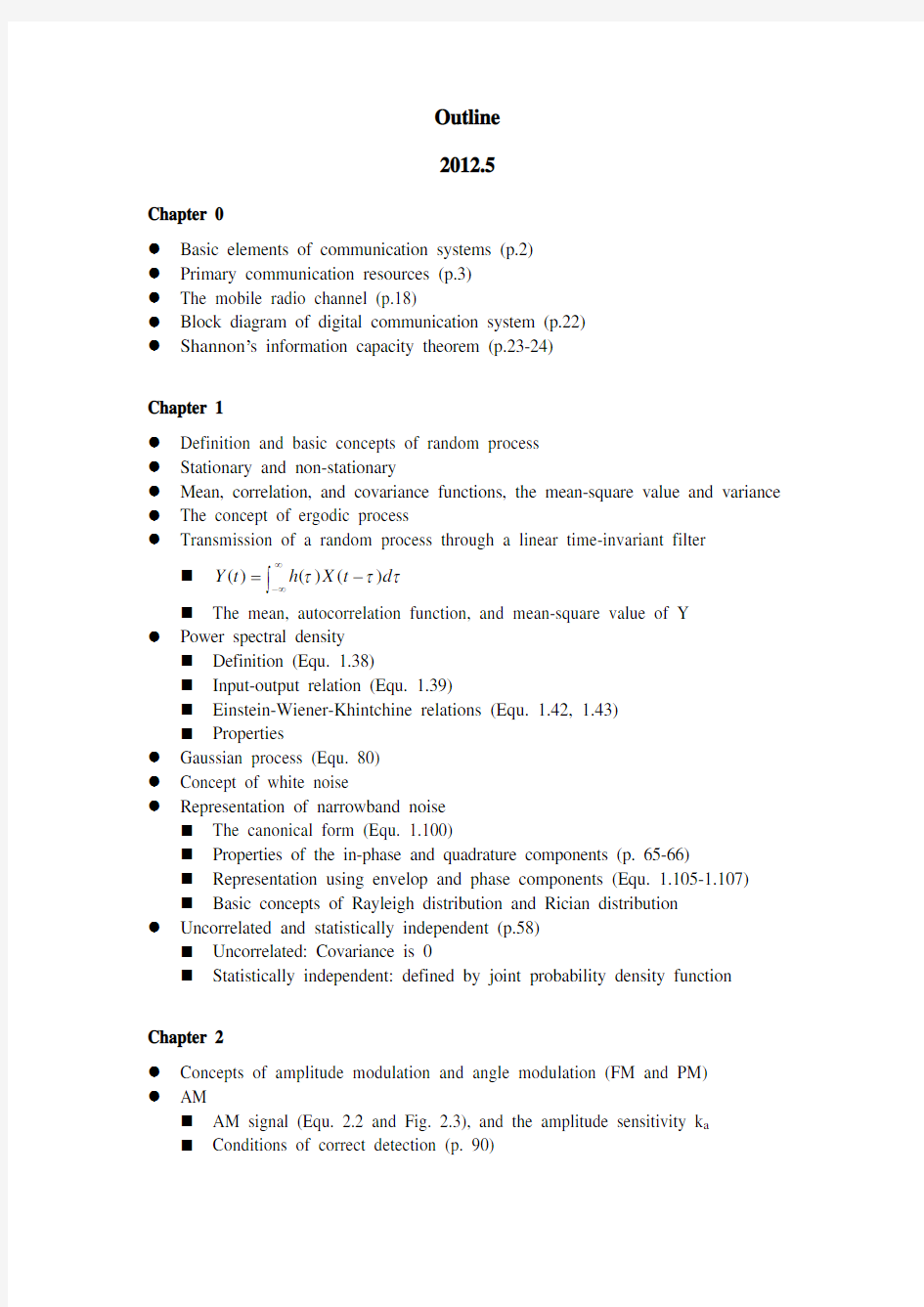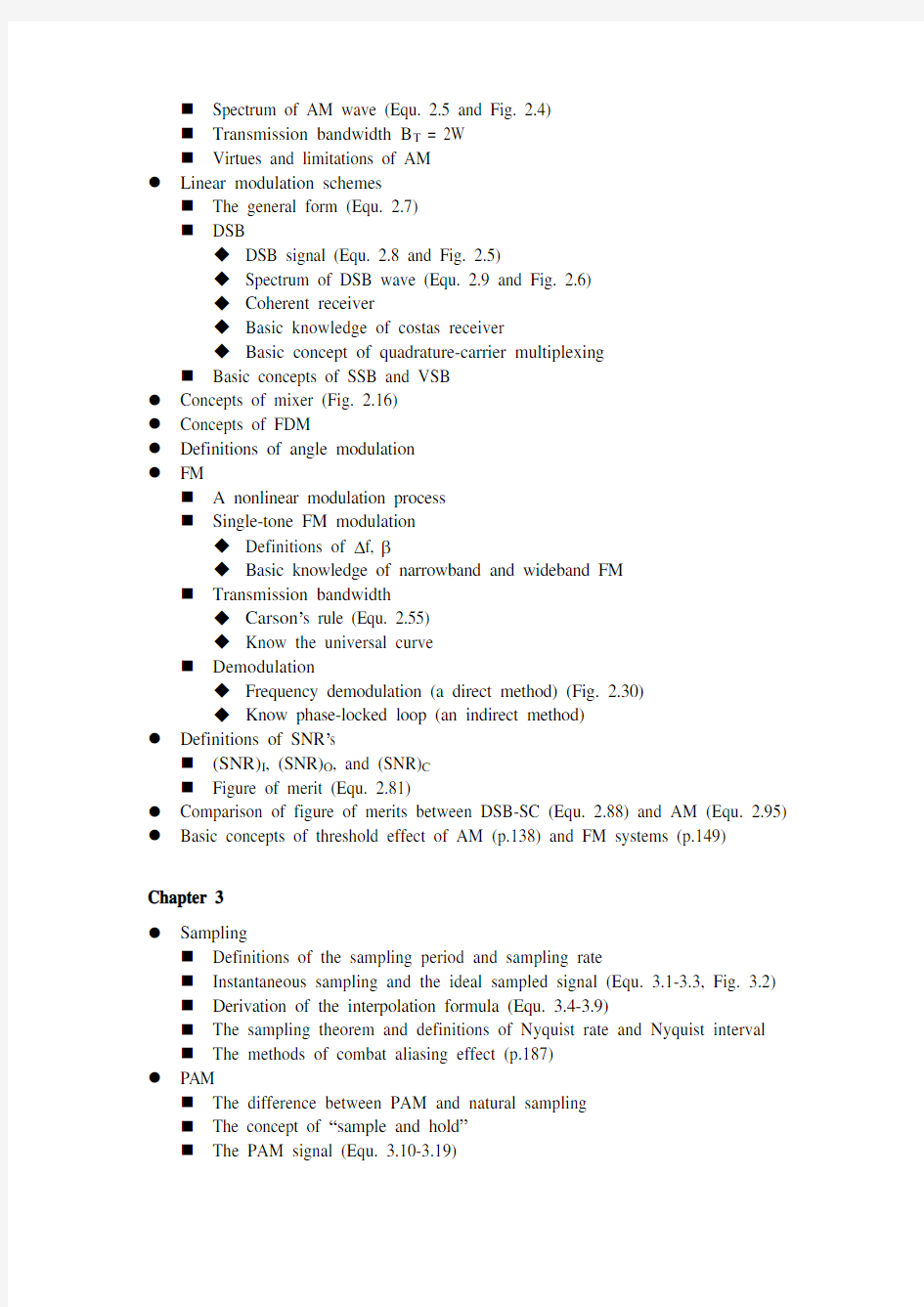

Outline
2012.5
Chapter 0
●
Basic elements of communication systems (p.2) ●
Primary communication resources (p.3) ●
The mobile radio channel (p.18) ●
Block diagram of digital communication system (p.22) ●
Shannon ’s information capacity theorem (p.23-24)
Chapter 1
●
Definition and basic concepts of random process ●
Stationary and non-stationary ●
Mean, correlation, and covariance functions, the mean-square value and variance ●
The concept of ergodic process ● Transmission of a random process through a linear time-invariant filter ? ?∞
∞--=τττd t X h t Y )()()( ? The mean, autocorrelation function, and mean-square value of Y ●
Power spectral density ? Definition (Equ. 1.38) ? Input-output relation (Equ. 1.39) ? Einstein-Wiener-Khintchine relations (Equ. 1.42, 1.43) ? Properties ●
Gaussian process (Equ. 80) ●
Concept of white noise ●
Representation of narrowband noise ? The canonical form (Equ. 1.100) ? Properties of the in-phase and quadrature components (p. 65-66) ? Representation using envelop and phase components (Equ. 1.105-1.107) ? Basic concepts of Rayleigh distribution and Rician distribution ● Uncorrelated and statistically independent (p.58)
? Uncorrelated: Covariance is 0
? Statistically independent: defined by joint probability density function
Chapter 2
● Concepts of amplitude modulation and angle modulation (FM and PM) ● AM
? AM signal (Equ. 2.2 and Fig. 2.3), and the amplitude sensitivity k a
? Conditions of correct detection (p. 90)
?Spectrum of AM wave (Equ. 2.5 and Fig. 2.4)
?Transmission bandwidth B T = 2W
?Virtues and limitations of AM
●Linear modulation schemes
?The general form (Equ. 2.7)
?DSB
◆DSB signal (Equ. 2.8 and Fig. 2.5)
◆Spectrum of DSB wave (Equ. 2.9 and Fig. 2.6)
◆Coherent receiver
◆Basic knowledge of costas receiver
◆Basic concept of quadrature-carrier multiplexing
?Basic concepts of SSB and VSB
●Concepts of mixer (Fig. 2.16)
●Concepts of FDM
●Definitions of angle modulation
●FM
? A nonlinear modulation process
?Single-tone FM modulation
◆Definitions of ?f, β
◆Basic knowledge of narrowband and wideband FM
?Transmission bandwidth
◆Carson’s rule (Equ. 2.55)
◆Know the universal curve
?Demodulation
◆Frequency demodulation (a direct method) (Fig. 2.30)
◆Know phase-locked loop (an indirect method)
●Definitions of SNR’s
?(SNR)I, (SNR)O, and (SNR)C
?Figure of merit (Equ. 2.81)
●Comparison of figure of merits between DSB-SC (Equ. 2.88) and AM (Equ. 2.95) ●Basic concepts of threshold effect of AM (p.138) and FM systems (p.149) Chapter 3
●Sampling
?Definitions of the sampling period and sampling rate
?Instantaneous sampling and the ideal sampled signal (Equ. 3.1-3.3, Fig. 3.2)
?Derivation of the interpolation formula (Equ. 3.4-3.9)
?The sampling theorem and definitions of Nyquist rate and Nyquist interval
?The methods of combat aliasing effect (p.187)
●PAM
?The difference between PAM and natural sampling
?The concept of “sample and hold”
?The PAM signal (Equ. 3.10-3.19)
?The aperture effect
●Know PPM and PDM
●Quantization
?Quantization noise and (SNR)O of a uniform quantizer (Equ. 3.25-3.33)
●PCM
?Basic concepts
◆Discrete in both time and amplitude
◆Sampling, quantizing, and encoding
?Non-uniform quantizers
◆μ-law and A-law
◆Piecewise linear approximation to the companding circuit
?Five types of line codes and their waveforms
?Differential encoding
?Noise in PCM systems
◆Know that noise including channel noise and quantization noise, and that
performance is essentially limited by the quantization noise
●Concepts of TDM (Fig. 3.19)
●Know the basic concept of digital hierarchy (p.214) and that the basic rate is 64
kbps
●Concepts of DM and delta-sigma modulation
●Concepts of linear prediction and linear adaptive prediction
●DPCM and its processing gain (Equ. 3.82)
Chapter 4
●Two sources of bit errors: ISI and noise
●Matched filter
?Frequency response (Equ. 4.14) and impulse response (Equ. 4.16)
?Properties: the peak SNR dependents only on signal energy-to-noise psd ratio
at the filter input
●Error rate due to noise
?Derivation of Equ. 4.35
?The complementary error function (Equ. 4.29)
?The result with equiprobable input signals (Equ. 4.38-4.40)
●The baseband data transmission system model (Fig. 4.7 and Equ. 4.44-4.48)
●Nyquist’s criterion
?The Nyquist’s criterion (p.262)
?The ideal Nyquist channel (Equ. 4.54-4.56 and Fig. 4.8, 4.9)
?Raised cosine spectrum (Equ. 4.59, Fig. 4.10)
◆The definition of α and the bandwidth B T
●Correlative-level coding (partial response signaling)
?Duobinary signaling (class I partial response)
◆Basic concepts (Fig. 4.11, 4.13, Equ. 4.66, 4.71)
◆The concept of decision feedback
◆Error-propagation and precoding
?Generalized form of correlative-level coding
●Baseband M-ary PAM transmission (Equ. 4.84)
●ADSL (Fig. 4.26)
●Optimum linear receiver
?For linear channel with both ISI and noise
?The MMSE receiver (Equ. 4.110 and Fig. 4.27)
●Adaptive equalization
?The LMS algorithm (Equ. 4.114, 4.115)
?The basic concept of decision-feedback equalization (Fig. 4.32)
Chapter 5
●Geometric representation of signals (Equ. 5.5-5.7 and Fig. 5.3)
?The vector form (Equ. 5.8) and definitions of length, Euclidean distance, and
angle
?Gram-Schmidt orthogonalization procedure
●Conversion of the continuous AWGN channel into a vector channel
?Basic formulations (Equ. 5.28-5.34)
?The vector representation represents sufficient statistics for detection
●Log-likelyhood functions for AWGN channel (Equ. 5.51)
●Maximum likelihood decoding
?The concept of signal constellation
?The maximum likelihood rule (Equ. 5.55), for AWGN channel, the rule is
Equ. 5.59 and 5.61
●Equivalence of correlation and matched filter sampled at time T
●Probability of error
?Know the invariance to rotation and translation
?The concept of the minimum energy signals
?Know how to use union bound to derive a upper bound (p. 332 – 335) (Equ.
5.89)
?Know that there is, in general, no unique relationships between symbol error
probabilities and BER
Chapter 6
●Basic concepts of keying and ASK, FSK, and PSK
●The relationship between baseband and passband power spectral density (Equ.
6.4)
●Bandwidth efficiency (Equ. 6.5)
●The passband transmission model
●Coherent PSK
?BPSK
◆Basic definitions (Equ. 6.8-6.14, Fig. 6.3)
◆Error probability (Equ. 6.20)
?QPSK
◆Basic definitions (Equ. 6.23-6.27)
◆Error probability (Equ. 6.34, 6.38)
◆Generation and detection (Fig. 6.8)
?M-PSK
◆Basic definitions (Equ. 6.46)
◆Bandwidth efficiency
◆Know that the power spectra of M-PSK has no discrete frequency
component
●M-QAM
?Basic definitions (Equ. 6.53-6.55)
?QAM square constellations (Fig. 6.17)
●Coherent FSK
?Coherent BFSK
◆Basic definitions (Sunde’s FSK) (Equ. 6.86-6.91, Fig. 6.25)
◆Error probability (Equ. 6.102)
◆Know that the power spectra of BFSK has discrete frequency
components
?MSK
◆The concept of CPFSK
◆The concept of MSK
◆The phase trellis
◆Signal-space diagram (Fig. 6.29)
◆Error probability (Equ. 6.127)
?Bandwidth efficiency of M-FSK signals
●Noncoherent receivers (Fig. 6.37)
●The reason of envelop detection (Fig. 6.38)
●Error probability of noncoherent receiver (Equ. 6.163)
●Noncoherent BFSK
?Receiver structure (Fig. 6.42)
?Error probability (Equ. 6.181)
●DPSK
?Basic concepts (Fig. 6.43, 6.44)
?Error probability (Equ. 6.184)
●Comparison of digital modulation schemes
?Relationship among the error probabilities (Table 6.8 and Fig. 6.45)
?Bandwidth efficiencies of M-PSK, M-QAM, and M-FSK